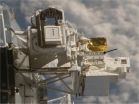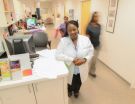(Press-News.org) In the movies, humans often fear invaders from Mars. These days, scientists are more concerned about invaders to Mars, in the form of micro-organisms from Earth. Three recent scientific papers examined the risks of interplanetary exchange of organisms using research from the International Space Station. All three, Survival of Rock-Colonizing Organisms After 1.5 Years in Outer Space, Resistance of Bacterial Endospores to Outer Space for Planetary Protection Purposes and Survival of Bacillus pumilus Spores for a Prolonged Period of Time in Real Space Conditions, have appeared in Astrobiology Journal.
Organisms hitching a ride on a spacecraft have the potential to contaminate other celestial bodies, making it difficult for scientists to determine whether a life form existed on another planet or was introduced there by explorers. So it's important to know what types of micro-organisms from Earth can survive on a spacecraft or landing vehicle.
Currently, spacecraft landing on Mars or other planets where life might exist must meet requirements for a maximum allowable level of microbial life, or bioburden. These acceptable levels were based on studies of how various life forms survive exposure to the rigors associated with space travel.
"If you are able to reduce the numbers to acceptable levels, a proxy for cleanliness, the assumption is that the life forms will not survive under harsh space conditions," explains Kasthuri J. Venkateswaran, a researcher with the Biotechnology and Planetary Protection Group at NASA's Jet Propulsion Laboratory and a co-author on all three papers. That assumption may not hold up, though, as recent research has shown that some microbes are hardier than expected, and others may use various protective mechanisms to survive interplanetary flights.
Spore-forming bacteria are of particular concern because spores can withstand certain sterilization procedures and may best be able to survive the harsh environments of outer space or planetary surfaces. Spores of Bacillus pumilus SAFR-032 have shown especially high resistance to techniques used to clean spacecraft, such as ultraviolet (UV) radiation and peroxide treatment. When researchers exposed this hardy organism to a simulated Mars environment that kills standard spores in 30 seconds, it survived 30 minutes. For one of the recent experiments, Bacillus pumilus SAFR-032 spores were exposed for 18 months on the European Technology Exposure Facility (EuTEF), a test facility mounted outside the space station.
"After testing exposure to the simulated Mars environment, we wanted to see what would happen in real space, and EuTEF gave us the chance," says Venkateswaran. "To our surprise, some of the spores survived for 18 months." These surviving spores had higher concentrations of proteins associated with UV radiation resistance and, in fact, showed elevated UV resistance when revived and re-exposed on Earth.
The findings also provide insight into how robust microbial communities are able to survive in extremely hostile regions on Earth and how these microbes are affected by radiation.
In another investigation, spores of Bacillus pumilus SAFR-032 and another spore-forming bacteria, Bacillus subtilis 168, were dried on pieces of spacecraft-quality aluminum and subjected for 1.5 years to the vacuum of space, cosmic and extraterrestrial solar radiation and temperature fluctuations on EuTEF. These samples also were subjected to a simulated Martian atmosphere using EuTEF. Most of the organisms exposed to solar UV radiation in space and in the Mars spectrum were killed, but when UV rays were filtered out and samples were kept in the dark, about 50 percent or more of those subjected to other space- and Mars-like conditions survived. That makes it likely that spores could survive a trip on a spacecraft to Mars if they are sheltered against solar radiation, perhaps in a tiny pocket of the spacecraft surface or underneath a layer of other spores.
The third study placed rock-colonizing cellular organisms in the EuTEF facility for 1.5 years, further testing a theory of how organisms might move from one planet to another, known as lithopanspermia. In this scenario, rocks ejected from a planet by impact with, say, a meteor, carried organisms on their surface through space and then landed on another planet, bringing that life with them. For this investigation, researchers selected organisms especially adapted to cope with the environmental extremes of their natural habitats on Earth, and found that some are also able to survive in the even more hostile environment of outer space. Lithopanspermia would require thousands or even millions of years, much longer than the experiment's duration, but results provide the first evidence of the hardiness of these organisms in space and suggest the possibility that space-traveling rocks could carry life between planets.
Future exploration missions can use the results of these investigations to help find ways to minimize the risk of contaminating another planet. The findings also will help prevent scientists from incorrectly identifying an organism that hitchhiked on the exploring spacecraft as a native of the planet, when in fact it's an invader. That's a good thing, because no one wants to be responsible for an alien invasion of Mars.
INFORMATION:
Space Station research shows that hardy little space travelers could colonize Mars
2014-05-02
ELSE PRESS RELEASES FROM THIS DATE:
Story tips from the Department of Energy's Oak Ridge National Laboratory, May 2014
2014-05-02
To arrange for an interview with a researcher, please contact the Communications staff member identified at the end of each tip. For more information on ORNL and its research and development activities, please refer to one of our media contacts. If you have a general media-related question or comment, you can send it to news@ornl.gov.
DIESELS – Reducing soot . . .
Nine U.S. diesel engine manufacturers and Oak Ridge National Laboratory are using their collective horsepower to tackle the perennial industry-wide problem of efficiency-robbing soot in engines. Over time, ...
Vanderbilt study explores genetics behind Alzheimer's resiliency
2014-05-02
Autopsies have revealed that some individuals develop the cellular changes indicative of Alzheimer's disease without ever showing clinical symptoms in their lifetime.
Vanderbilt University Medical Center memory researchers have discovered a potential genetic variant in these asymptomatic individuals that may make brains more resilient against Alzheimer's.
"Most Alzheimer's research is searching for genes that predict the disease, but we're taking a different approach. We're looking for genes that predict who among those with Alzheimer's pathology will actually show ...
Researchers find way to decrease chemoresistance in ovarian cancer
2014-05-02
ATLANTA--Inhibiting enzymes that cause changes in gene expression could decrease chemotherapy resistance in ovarian cancer patients, researchers at Georgia State University and the University of Georgia say.
Dr. Susanna Greer, associate professor of biology, and research partners at the University of Georgia have identified two enzymes that suppress proteins that are important for regulating cell survival and chemoresistance in ovarian cancer. Their findings are published in the journal, PLOS ONE.
Ovarian cancer is one of the deadliest gynecological cancers, with a ...
A transcription factor called SLUG helps determines type of breast cancer
2014-05-02
Findings and Significance: During breast-tissue development, a transcription factor called SLUG plays a role in regulating stem cell function and determines whether breast cells will mature into luminal or basal cells.
Studying factors, such as SLUG, that regulate stem-cell activity and breast-cell identity are important for understanding how breast tumors arise and develop into different subtypes. Ultimately, this knowledge may help the development of novel therapies targeted to specific breast-tumor subtypes.
Background: Stem cells are immature cells that can differentiate, ...
Key protein, FABP5, enhances memory and learning
2014-05-02
Case Western Reserve researchers have discovered that a protein previously implicated in disease plays such a positive role in learning and memory that it may someday contribute to cures of cognitive impairments. The findings regarding the potential virtues of fatty acid binding protein 5 (FABP5) — usually associated with cancer and psoriasis — appear in the May 2 edition of The Journal of Biological Chemistry.
"Overall, our data show that FABP5 enhances cognitive function and that FABP5 deficiency impairs learning and memory functions in the brain hippocampus region," ...
Better sleep predicts longer survival time for women with advanced breast cancer
2014-05-02
DARIEN, IL – A new study reports that sleep efficiency, a ratio of time asleep to time spent in bed, is predictive of survival time for women with advanced breast cancer.
Results show that higher sleep efficiency was significantly associated with lower mortality over the ensuing six years, an effect that remained after adjusting for baseline prognostic factors such as age, estrogen receptor status and treatments received. Mean survival was 68.9 months for efficient sleepers compared with 33.2 months for participants with poor sleep efficiency. Further analysis found that ...
How bacteria exploit proteins to trigger potentially lethal infections
2014-05-02
New research by scientists at the University of York sheds light on how bacteria exploit human proteins during infections.
A research team led by Professor Jennifer Potts, a British Heart Foundation Senior Research Fellow in York's Department of Biology, studied how Staphylococcus aureus, which can cause life-threatening human infections, attach to two proteins fibronectin and fibrinogen found in human blood.
The human proteins play important roles in clot formation and wound healing and the bacteria appear to exploit them during the process of infection.
Scientists ...
Element 117 discovered by Lawrence Livermore one step closer to being named
2014-05-02
Element 117, first discovered by Lawrence Livermore scientists and international collaborators in 2002, is one step closer to being named.
The existence of element 117 and its decay chain to elements 115 and 113 have been confirmed by a second international team led by scientists at GSI Helmholtz Centre for Heavy Ion Research, an accelerator laboratory located in Darmstadt, Germany. The research will appear in an upcoming issue of the journal, Physical Review Letters.
The next step is for the International Union of Pure and Applied Chemistry (IUPAC) to accept the confirmation. ...
Study shows link between sleep apnea and hospital maternal deaths
2014-05-02
Tampa, FL (May 2, 2014) -- Pregnant women with obstructive sleep apnea are more than five times as likely to die in the hospital than those without the sleep disorder, a comprehensive national study by the University of South Florida researchers found.
Among delivery-related hospital discharges, sleep apnea was also associated with an increase in severe medical conditions that are top causes of maternal death, including preeclampsia, eclampsia, an enlarged heart and pulmonary blood clots, reported the study published online this month in the journal SLEEP.
Sleep apnea ...
The Lancet: UK has one of the highest death rates for children in western Europe
2014-05-02
The UK has one of the highest rates of death for children under five in western Europe [1], according to new research published in The Lancet.
The findings come from a new study coordinated by the Institute for Health Metrics and Evaluation (IHME) at the University of Washington, Seattle, USA. Their figures provide a comprehensive new analysis of global progress towards reducing child mortality.
Although, by international standards, the UK has very low rates of deaths in children, the figures show that within western Europe, the UK has a higher rate of deaths in children ...


